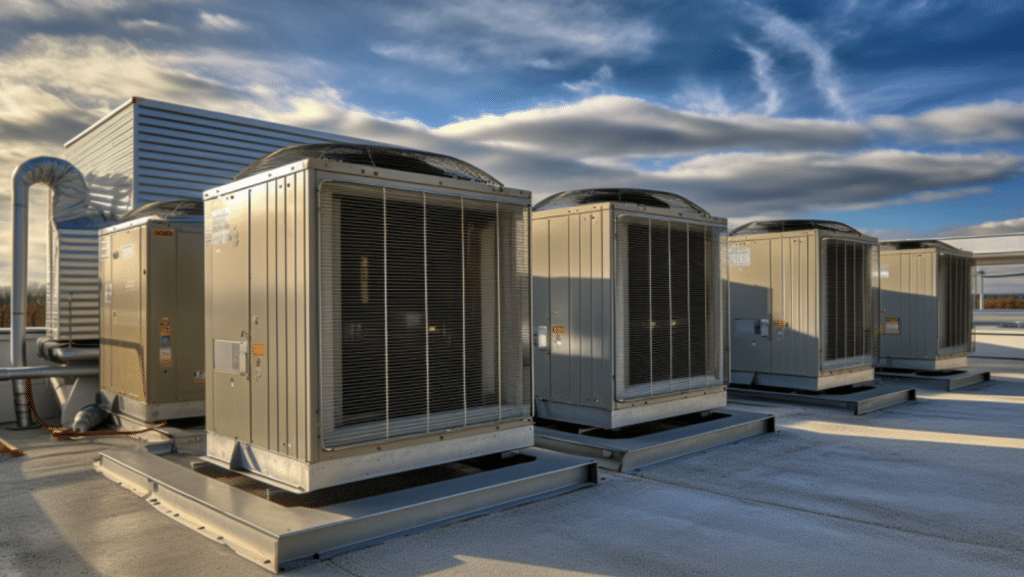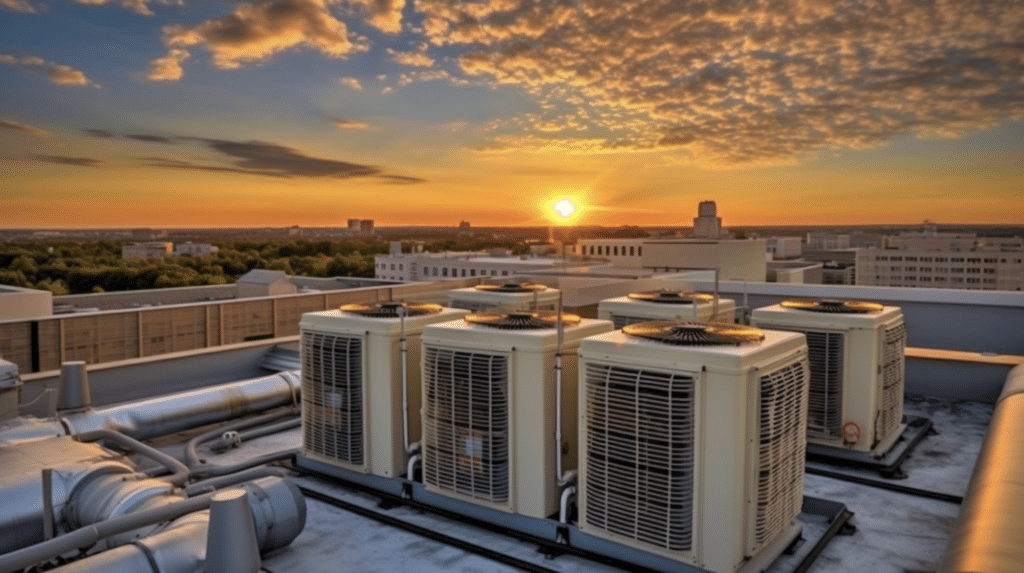Introduction – VRF, Mini-Splits And Heat Pumps
As technology continues to advance, so do the systems that regulate our indoor climates. One of the most notable innovations in this area is Variable Refrigerant Flow (VRF) technology. In this article, we will delve into the specifics of VRF heat pumps, its applications in mini-split and heat pump systems, and its comparison with traditional mini-splits.

VRF Is Used In Commercial Buildings With Limited Residential Use
There’s a reason why you haven’t heard of VRF. It’s because VRF (Variable Refrigerant Flow) systems are widely used in commercial buildings rather than residential buildings due to their energy efficiency, flexibility, and ability to provide individualized comfort control across multiple zones or rooms. They are particularly suitable for multi-tenant buildings, hotels, office buildings, and other large commercial spaces where different rooms may require different heating or cooling needs at the same time.
However, VRF systems are not limited to commercial applications. They are also used in high-end residential properties, multi-family housing, and other applications where advanced, efficient, and flexible heating and cooling systems are desired. The ability of VRF systems to condition multiple zones independently makes them a good choice for large residences with varying temperature needs across different rooms or areas.
Understanding VRF Technology
VRF technology, a type of HVAC system, provides precise control over the heating and cooling in individual areas, enhancing energy efficiency and comfort. A VRF system adjusts the flow of refrigerant to indoor units based on demand, providing optimal temperature control, energy savings, and more comfort. However, the complexity of the installation process and high upfront costs are among its potential drawbacks.
VRF in Mini-Split Systems
Mini-split systems are heating and cooling systems that allow you to control the temperatures in individual rooms or spaces. VRF technology, when used in mini-split systems, enhances their efficiency by adjusting the cooling or heating power based on the specific requirements of each zone. This results in more precise temperature control, greater comfort, and lower energy consumption. However, the cost and complexity of installation can be higher compared to traditional mini-split systems.
VRF in Heat Pump Systems
Heat pump systems transfer heat from one place to another, providing efficient cooling and heating for your home or office. When VRF technology is integrated into these systems, it allows for variable heat output based on the needs of different areas. This makes VRF heat pump systems highly efficient and flexible for various climates and usage scenarios. Just like with mini-splits, however, the primary considerations are higher upfront costs and more complex installation.
Comparison: VRF vs. Traditional Mini-Split Systems
While both VRF and traditional mini-split systems offer efficient heating and cooling, there are some key differences. VRF systems can deliver varying amounts of refrigerant to different zones based on their specific needs, providing more precise temperature control and energy efficiency. However, they are typically more expensive and require a more complex installation process.
On the other hand, traditional mini-split systems are usually cheaper and easier to install. They offer good efficiency but lack the zoning flexibility and ultra-efficient operation of VRF systems. Depending on the specific needs and budget, one system may be more suitable than the other.
Types and Models of VRF Heat Pumps
There are various types of VRF heat pumps available in the market, including heat pump systems (which can heat or cool, but not simultaneously) and heat recovery systems (which can heat and cool simultaneously). Each type has its own advantages, and the best choice depends on the specific requirements of your building.
Some of the leading companies in the VRF heat pump industry include Mitsubishi Electric, Daikin, LG, and Fujitsu. These manufacturers offer a range of VRF heat pump models, each with its own unique features and specifications.
- Mitsubishi Electric: Known for their CITY MULTI VRF systems, Mitsubishi Electric offers both heat pump and heat recovery systems. Their products are highly regarded for their energy efficiency, quiet operation, and innovative controls.
- Daikin: Daikin’s VRV (Variable Refrigerant Volume) systems provide a wide range of heat pump and heat recovery options. The brand is known for its inverter technology, which ensures optimal performance and energy efficiency.
- LG: LG’s Multi V VRF systems come in various capacities and configurations, suitable for both residential and commercial applications. Their systems are designed to be compatible with LG’s smart home ecosystem, providing users with advanced control options.
- Fujitsu: Fujitsu’s Airstage VRF systems provide energy-efficient heating and cooling solutions for commercial applications. Their systems are recognized for their compact design, easy installation, and advanced control options.
When choosing a VRF heat pump, consider factors like your climate, the size and usage of the building, the system’s efficiency, and your budget. Additionally, be sure to research the specific features and capabilities of each brand and model to make an informed decision that best meets your needs.
VRF In Japan
The fact that many leading VRF manufacturers, such as Mitsubishi Electric, Daikin, and Fujitsu, are Japanese is a testament to Japan’s strong reputation in technological innovation, especially in the HVAC industry. Japan’s emphasis on energy efficiency, technological advancement, and high-quality manufacturing standards have contributed to these companies’ success in developing and promoting VRF systems globally.
The VRF technology itself was developed in Japan in the 1980s, with Daikin Industries introducing the first VRF system, known as VRV (Variable Refrigerant Volume). This innovation has set a precedent, leading to Japan’s dominance in this sector.
South Korea’s LG stands out also for significant contributions to the VRF market.

Conclusion – VRF, Mini-Splits And Heat Pumps
VRF technology offers a highly efficient and flexible solution for heating and cooling needs. Whether integrated into mini-split or heat pump systems, it provides enhanced temperature control and energy efficiency. However, the initial investment and installation complexity are important factors to consider Regardless of the choice, both systems can provide efficient, reliable climate control for your home or office.

Anne Lauer
Anna Lauer is a writer, gardener, and homesteader living in rural Wisconsin. She has written for Mother Earth News, Grit, and Hobby Farms magazines. Anna is writing a new book about growing your food for free and an ultimate guide to producing food at little to no cost. When she’s not writing or gardening, Anna enjoys spending time with her husband and two young daughters.
